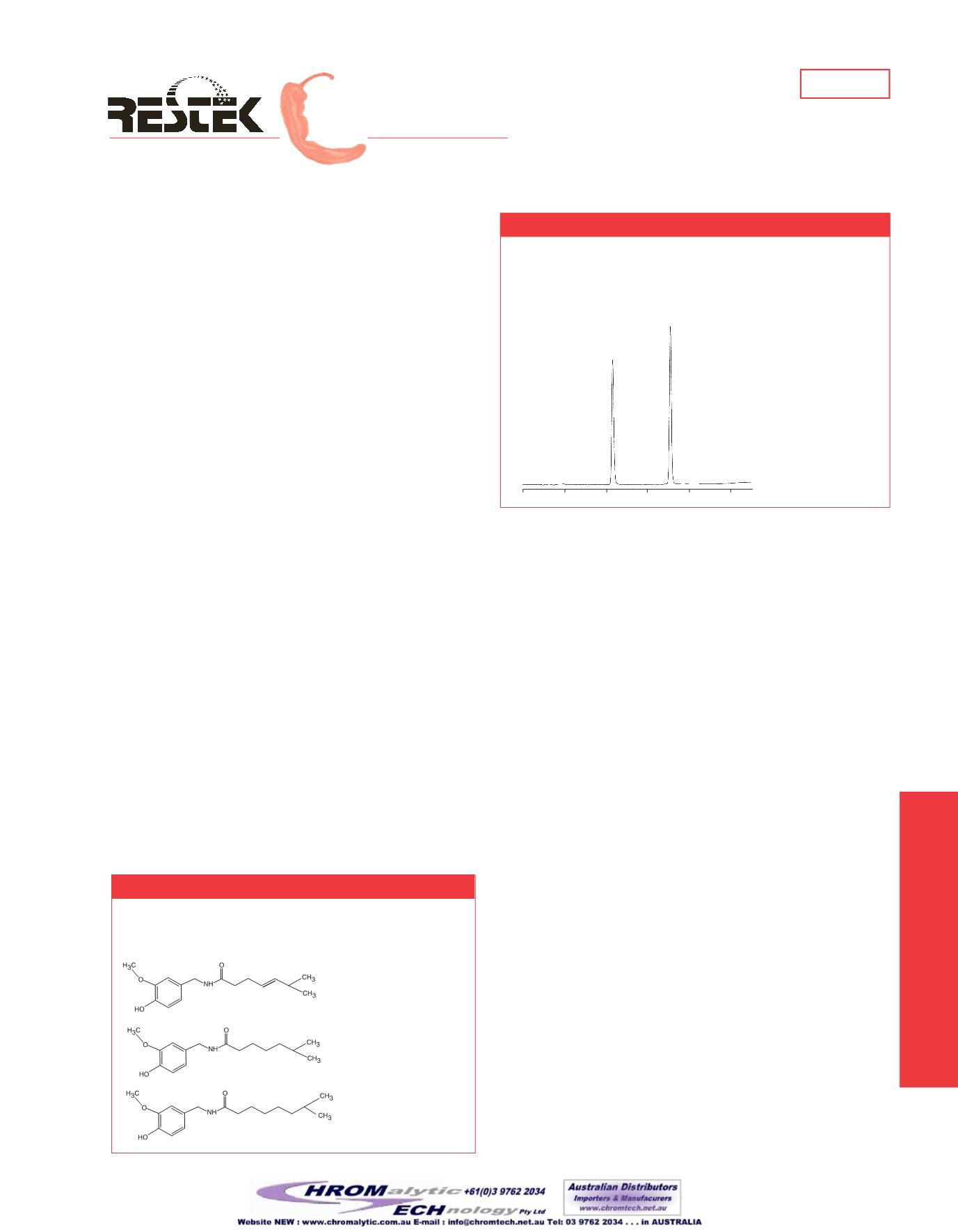
Introduction
Spicy foods and sauces can be used to add zest to bland foods
and to buildmore complex flavors in a variety of food types.
They provide a nutritiousway to add flavor to "healthy foods,"
such as low-salt, low-fat alternatives. Chili pepper extracts
also are being explored for theirmedicinal uses, including
rubdown liniments, arthritis pain lotions, and counter-irritant
balms.As society's taste in spicy foods grows, so does the
need to test and classify products and rawmaterials for their
pungency (i.e., heat levels). Pungency is defined as the hot,
sharp, stinging sensations experienced by the nasal and oral
cavities and the tonguewhen certain flavor compounds contact
them.
1
The trigeminal nerves in these areas are stimulated,
tricking the body into thinking it is in pain. Then the body
releases endorphins, which give a pleasant sensation.
In chili peppers, black pepper, and ginger, the pungent species
are not volatile. Flavorings such asmustard, garlic, and horse-
radish, on the other hand, contain volatile compounds that
contribute aroma aswell as pungency. Pungency can differ
both in intensity and duration, depending on the chemical
species present.
There are over 200 chili pepper varieties, with awide range
of pungency levels and flavor profiles.
2
Chili peppers belong
to the genus Capsicum, which contains five domesticated
species. In chili peppers, pungency is a result of capsaicinoids,
or vanillylamides ofmonocarboxylic acids. The capsaicinoid
content, and thus the heat level, depends on the type of pepper,
maturity, growing conditions, and processingmethods.Most
of the capsaicinoids can be found in the inner layer of the
plant, including the placentawhere the seeds attach. Only
small amounts of capsaicinoids are found in the seeds them-
selves. There are seven generally recognized capsaicinoids in
chili peppers, all of which evoke different responses in the
consumer: Themost famous and the hottest is capsaicin
(CAP). In chili peppers, CAPand dihydrocapsaicin (DHC) are
present in the greatest amounts and are the largest contributors
to the heat level (Figure 1). Theminor capsaicinoids include
nordihydrocapsaicin (NDC), homocapsaicin, norcapsaicin,
nornorcapsaicin, and homodihydrocapsaicin.
food& flavor
Applications
note
Restek Corporation • (800) 356-1688 • (814) 353-1300 •
#59199
food& flavor
Analyzing theHeat Level of Spicy FoodsUsing anUltraC18HPLC column
Figure 2
TheUltraC18 column and a gradient elution program
result in a fast, reproducible separation.
Historical Perspectives
In 1912,Wilbur Scoville developed amethod for determining heat
levels. In this organoleptic (i.e., affecting the qualities of sub-
stances that stimulate the sense organs) procedure, a ScovilleHeat
Unit (SHU) is defined as the number of parts sugar water needed
to neutralize the heat of one part sample extract. For example, if
the heat of a cayenne pepper is 30,000 SHU, that means 30,000
parts of sugar water are needed to dilute one part of cayenne pep-
per extract to the last point that hotness can be detected. However,
there are several problemswith the organoleptic procedure for
determining heat levels. The test is somewhat subjective because it
relies on the tasters' palates and sensitivity. The geographic area or
culture fromwhich the taster originates can affect the results—dif-
ferent groups of people have different physical perceptions of heat.
In addition, tasters can handle only a limited number of samples at
one time, before "fatiguing of the palate" occurs.
3
This canmake it
difficult to process a large number of samples in a reasonable
amount of time, such as in a quality control (QC) environment,
and can affect the reproducibility of the tests.
Analytical Methods
Starting in the 1970s, several analytical methods for heat level
measurement were introduced to overcome the limitations of the
organoleptic procedure.
4
These includedwet chemical methods;
spectrometry; and paper, gas (GC), and liquid chromatography
(HPLC). Of these, theHPLC procedures have provided the
greatest specificitywhile requiring the least amount of sample
preparation. TheAmerican SpiceTradeAssociation (ASTA) and
theAssociation of OfficialAnalytical Chemists (AOAC) have
publishedmethods for the determination of capsaicinoids by
HPLC.AOACMethod 995.03
5
specifies the separation of three
target capsaicinoids using reversed phaseHPLC on aC18 column,
and quantitation using either UVor fluorescence detection. This
method is performed isocraticallywith a 1% acetic acid:acetoni-
trile (60:40)mobile phase. Standardization is performed using
synthetic capsaicin, N-vanillyl-
n
-nonanamide; and the relative
amounts of CAP, DHC, andNDC are calculated by applying the
specified factors. Using the appropriate calculations, the heat index
can then be calculated, where 1ppm of total capsaicinoids is
approximately equal to 15 SHU.
LC_0155
Column:
UltraC18
Catalog#:
9174565
Dimensions: 150x4.6mm
Particle size: 5µm
Pore size:
100Å
Conditions:
Mobile phase: A: 1% acetic acid
inwater
B: acetonitrile
Time (min.)
%B
0
50
2
50
9
80
12
80
13
50
Flow:
1.0mL/min.
Temp.:
ambient
Det.:
UV@ 280nm
PeakList:
1. capsaicin
Sample:
Inj.:
10µL
Conc.:
110 ppm capsaicin
Solvent: ethanol
0
2
4
6
8
10min.
1
capsaicin
(CAP)
dihydrocapsaicin
(DHC)
nordihydrocapsaicin
(NDC)
Figure 1
CAPandDHC are consideredmajor contributors to the
heat level. NDC is aminor capsaicinoid, which also
contributes to the heat level.


